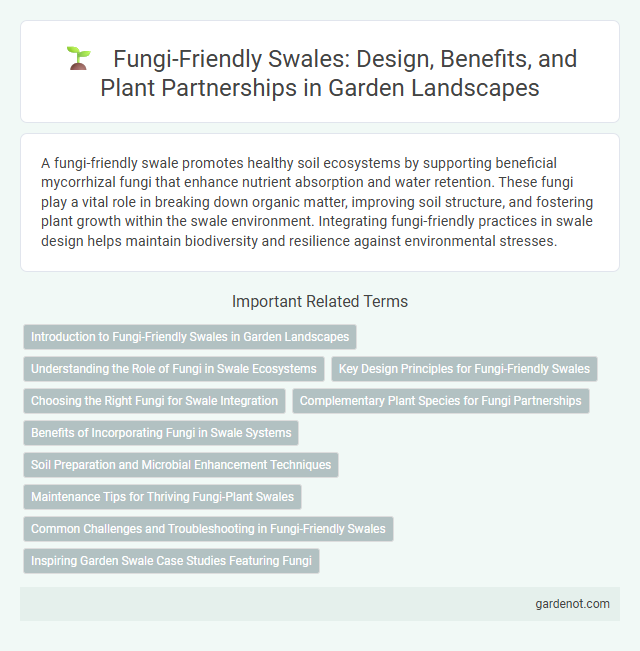A fungi-friendly swale promotes healthy soil ecosystems by supporting beneficial mycorrhizal fungi that enhance nutrient absorption and water retention. These fungi play a vital role in breaking down organic matter, improving soil structure, and fostering plant growth within the swale environment. Integrating fungi-friendly practices in swale design helps maintain biodiversity and resilience against environmental stresses.
Introduction to Fungi-Friendly Swales in Garden Landscapes
Fungi-friendly swales enhance garden landscapes by promoting soil health and biodiversity through natural fungal networks that improve nutrient cycling and water retention. These swales are designed with organic mulch and native plantings to create ideal conditions for beneficial mycorrhizal fungi, which support plant growth and soil structure. Integrating fungi-friendly swales into landscape design fosters resilient ecosystems and sustainable water management.
Understanding the Role of Fungi in Swale Ecosystems
Fungi in swale ecosystems play a crucial role in nutrient cycling by breaking down organic matter and enhancing soil fertility. Mycorrhizal fungi form symbiotic relationships with plant roots, improving water absorption and resilience to environmental stress. Supporting fungi-friendly swales promotes biodiversity and strengthens ecosystem functions critical for sustainable water management and soil health.
Key Design Principles for Fungi-Friendly Swales
Designing fungi-friendly swales involves maintaining moist, shaded environments with diverse organic matter to support fungal growth and biodiversity. Incorporating native woody debris and mulch enhances soil structure, while avoiding chemical pesticides preserves beneficial fungal communities. Proper gradient and water retention ensure sustained moisture levels critical for fungal colonization and nutrient cycling.
Choosing the Right Fungi for Swale Integration
Selecting the right fungi for swale integration involves prioritizing species that enhance soil health and water retention while supporting native plant growth. Mycorrhizal fungi, such as arbuscular mycorrhizal and ectomycorrhizal varieties, form symbiotic relationships with plant roots, improving nutrient uptake and drought resistance in swale environments. Incorporating saprophytic fungi like oyster mushrooms can accelerate organic matter decomposition, enriching soil fertility and promoting a balanced ecosystem within the swale.
Complementary Plant Species for Fungi Partnerships
Swales designed with fungi-friendly principles integrate complementary plant species such as native grasses, nitrogen-fixing legumes, and mycorrhizal-host trees to enhance fungal symbiosis and soil health. These plants promote mycelial networks that improve water infiltration, nutrient cycling, and organic matter decomposition within the swale ecosystem. Incorporating species like clover, alder, and oak supports diverse fungal communities critical for ecosystem resilience and swale functionality.
Benefits of Incorporating Fungi in Swale Systems
Incorporating fungi in swale systems enhances soil structure and water retention by breaking down organic matter and forming symbiotic relationships with plant roots. Fungi facilitate nutrient cycling, improving the availability of essential minerals such as phosphorus and nitrogen critical for healthy vegetation growth. Their presence also supports biodiversity, promoting a resilient ecosystem that helps prevent erosion and filters pollutants within the swale.
Soil Preparation and Microbial Enhancement Techniques
For fungi-friendly swale design, optimal soil preparation includes incorporating organic matter such as compost and mulch to boost soil fertility and structure, creating a conducive environment for fungal growth. Microbial enhancement techniques involve inoculating the soil with beneficial mycorrhizal fungi and employing biochar to promote microbial diversity and activity. Maintaining proper moisture levels through strategic swale grading supports fungal colonization and nutrient cycling essential for ecosystem function.
Maintenance Tips for Thriving Fungi-Plant Swales
Maintaining fungi-friendly swales requires regular monitoring of soil moisture to support mycorrhizal networks that enhance plant nutrient uptake. Incorporating organic mulches such as wood chips promotes fungal growth while suppressing weeds and stabilizing soil temperature. Avoid using chemical fungicides and minimize soil disturbance to preserve the delicate symbiotic relationships critical for thriving fungi-plant swale ecosystems.
Common Challenges and Troubleshooting in Fungi-Friendly Swales
Fungi-friendly swales often face challenges such as excessive moisture retention leading to waterlogging and root rot, as well as competition from invasive plant species that disrupt fungal networks. Troubleshooting involves improving soil drainage through selective grading and incorporating organic matter to balance moisture levels while monitoring and managing invasive species to protect the native fungal community. Regular soil testing and fungal health assessments help optimize conditions for beneficial mycorrhizal growth, ensuring the swale's ecological functionality.
Inspiring Garden Swale Case Studies Featuring Fungi
Fungi-friendly swales enhance soil health and water retention by promoting mycorrhizal networks crucial for plant growth. Case studies from inspiring garden swales reveal diverse fungal species like mycorrhizae and decomposers thriving in nutrient-rich, moisture-optimized environments. These ecosystems demonstrate increased biodiversity, improved soil structure, and sustainable water management, establishing fungi as key contributors to swale garden resilience.
Fungi-friendly swale Infographic

 gardenot.com
gardenot.com